Classroom Ideas for Women’s History Month
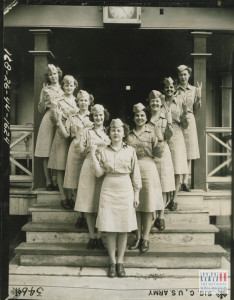
Army WACs (Women’s Army Corps) giving the “V” for Victory signal, 1944. U.S. Army Signal Corps, Gift in Memory of Maurice T. White, from the collection of The National WWII Museum. 2011.065.1347.
Women in WWII were essential to winning the war. Many of us tend to think of the iconic Rosie the Riveter when we think about women’s contributions during the war, and indeed over 6 million women worked in industrial jobs during WWII. However, American women contributed to the war effort in many other ways, and had to overcome gender stereotypes and discrimination to do so. This Women’s History Month, introduce your students to the variety of women’s WWII experiences with classroom resources from The National WWII Museum.
A great way to get your students to think about the changes in social expectations and work opportunities for women over time is to compare and contrast primary sources like yearbooks. Our “See You Next Year! High School Yearbooks from WWII” website at ww2yearbooks.org features yearbooks by state, including one from an all-girls Catholic school in Ohio, St. Ursula Academy. The 1945 Scroll yearbook shows Ursuline alumnae that were serving in the military at home and overseas, offers condolences for women who have lost family members, and contains student aspirations for life after the war. Teachers can have their students reflect on how 1940’s women’s roles are similar or different today by comparing their own contemporary yearbook with others from the WWII era, such as Louisiana’s Isidore Newman School or Illinois’s Carl Schurz High School, which show the highly gendered expectations for women to be caregivers and secretaries. There is even a lesson plan called “Society’s Struggles” which helps students explore how yearbooks show the intersection of inequalities regarding gender, race and ethnicity during the 1940s.
Resources like the Women at War Focus On feature, propaganda posters, and oral history interviews from The Digital Collections of The National WWII Museum illustrate the diversity of women’s WWII experiences. Whether it was serving in the military or the Red Cross at home and overseas, surviving life as a POW in the Pacific, to civilian work operating canteens and providing entertainment for soldiers, American women could be found almost everywhere during the war. Highlights from The Digital Collections include interviews with Lois Meyer, who challenged sexism as one of the first female officers in the U.S. Marine Corps; Martha Erickson discussing her top-secret work with the OSS (Office of Strategic Services; forerunner of the CIA); and Women Air Force Service Pilot (WASP) Helen Snapp, who talked about the dangers (including death) faced by some women aviators.
Although many post-war women, including millions of “Rosies,” were fired from their jobs to make room for returning men in the workforce, the impact of women’s powerful wartime experiences encouraged others to continue breaking social and economic barriers inside and outside of the home. Here are a few more educational suggestions for you to explore:
- Fact Sheet: Women in WWII
- Workers and Social Change segment, Manufacturing Victory: The Arsenal of Democracy special exhibit
- Lesson plans: The Working Women of WWII: Analyzing Editorial Cartoons and The Changing Face of Women: Propaganda and Popular Opinion During WWII
- Virtual Field Trip: It’s OUR War, Too! Women in WWII
- Worker Wednesday blog post series
For additional ideas and resources for Women’s History Month, please visit our Education blog, follow us on Twitter @wwiieducation and sign up for our free monthly e-newsletter, Calling All Teachers.
Post written by Megan Byrnes, K-12 Curriculum Coordinator.
- St. Ursuline Academy in Toledo, Ohio, was an all-girls Catholic school. This page from their 1945 yearbook highlights graduates' wartime service. See the whole yearbook at ww2yearbooks.org.
- A riveter works on a Vultee A-31 "Vengence" dive bomber in a Nashville, TN plant, Feb. 1943. Image courtesy of the Library of Congress.
- Movie star Bette Davis visits Fort Benning to raise troop morale, Oct. 1944. U.S. Army Signal Corps, Gift in Memory of Maurice T. White, from the collections of The National WWII Museum. 2011.065.1660.
- Helen Snapp was a female pilot who served in the WASPs (Women's Air Force Service Pilots). Despite their important and dangerous work flying and delivering planes, the WASPs were forced to disband in December 1944 and were denied military recognition and veterans benefits until the 1970s. Listen to her entire interview at ww2online.org.
- Navy nurse Jane Kendiegh tends to a wounded soldier on a ship off of Iwo Jima, 1945. Gift of Charles Ives, from the collection of The National WWII Museum. 2011.102.548.
- Champion welders, Delta Shipbuilding plant, 1943. Gift of Mildred Aupied, from the Collection of The National WWII Museum.
- Army WACs (Women's Army Corps) giving the "V" for Victory signal, 1944. From the collection of The National WWII Museum. 2011.065.1347.
- "Make a Date with Uncle Sam!"SPARS (Coast Guard) recruitment poster, Courtesy of The National Archives and Records Administration.



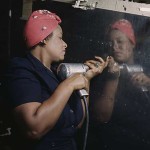
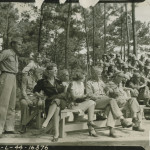
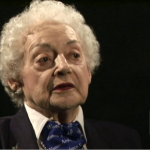
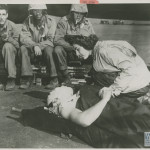
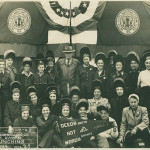
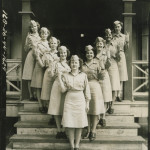
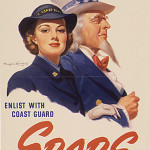


Leave a Reply